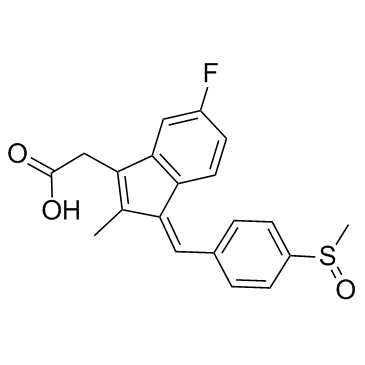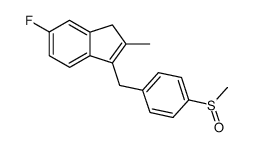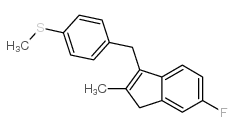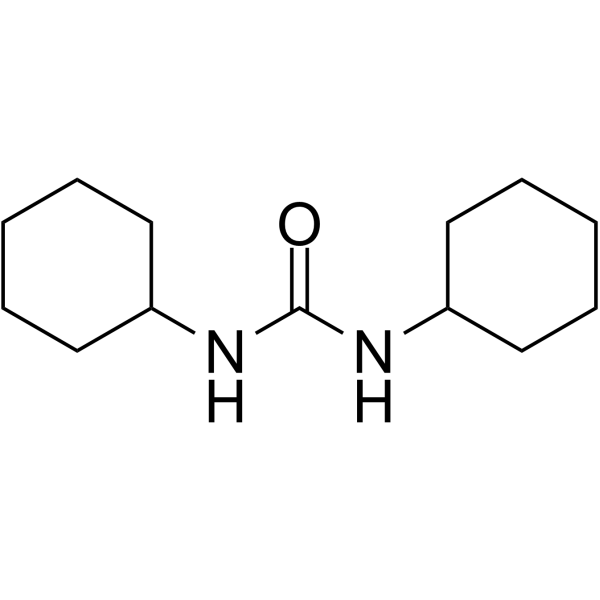38194-50-2
| 中文名 | 舒林酸 |
|---|---|
| 英文名 | sulindac |
| 中文别名 |
硫茚酸
(2)-5-氟-2-甲基-1-[(亚硫酰苯基)亚甲基]-1H-茚-3-醋酸 (Z)-5-氟-2-甲基-1-[4-(甲亚硫酰苯基)亚甲基]-1H-茚-3-醋酸 (Z)-5-氟-2-甲基-1-[4-(甲亚硫酰苯基)亚甲基]-1H-茚-3-醋酸 |
| 英文别名 |
AFLODAC
Imbaral Saldac {5-Fluoro-2-methyl-1-[4-(methylsulfinyl)benzylidene]-1H-inden-3-yl}acetic acid SULREUMA MFCD00599589 Sudac (Z)-2-(3-(4-(methylsulfinyl)benzylidene)-6-fluoro-2-methyl-3H-inden-1-yl)acetic acid Aclin ReuMyl SULINOL mobilin 1H-Indene-3-acetic acid, 5-fluoro-2-methyl-1-[[4-(methylsulfinyl)phenyl]methylene]- Clinoril,Aflodac,Sulreuma Sulindac MK-231 EINECS 253-819-2 (Z)-2-(5-Fluoro-2-methyl-1-(4-(methylsulfinyl)benzylidene)-1H-inden-3-yl)acetic acid (Z)-5-Fluoro-2-methyl-1-[p-(methylsulfinyl)benzylidene]indene-3-acetic acid |
| 描述 | Sulindac 是一种非甾体类抗炎剂,能够抑制 COX-2 的活性,同时可抑制 COX-2 的过表达。 |
|---|---|
| 相关类别 | |
| 靶点 |
COX-2 Autophagy |
| 体外研究 | 舒林酸是一种非甾体类抗炎药,可作为COX-2抑制剂,抑制COX-2的过度表达[1]。舒林酸(0.1 mM至0.5 mM)导致p53 wt和p53 null HCT116细胞死亡有限,但与维生素C组合,相对于单独的维生素C,p53 wt HCT116细胞的细胞死亡率显着增加近5倍,这种作用涉及这些细胞中的半胱天冬酶活化和p53功能,并通过ROS介导的途径。舒林酸联合维生素C可显着提高PUMA水平,但对Bim,Bcl-2和Mcl-1水平没有影响[2]。舒林酸(500μM)与塞来昔布联合阻断转化生长因子(TGF)-β1诱导的A549细胞上皮-间质转化,迁移和侵袭。该组合还抑制sirtuin 1(SIRT1)参与转化生长因子(TGF)-β1诱导的上皮-间质转化(EMT)[3]。 |
| 体内研究 | 舒林酸(0.5±0.1毫克/天)可降低COX,改善PGE2水平并防止Min小鼠肿瘤形成[1]。 |
| 细胞实验 | 用指定剂量的舒林酸和/或维生素C处理细胞48小时,并使用台盼蓝排除测定法分析细胞活力。对于膜联蛋白V染色测定,用0.5mM舒林酸和/或0.5mM维生素C处理细胞48小时。然后将细胞用胰蛋白酶消化,用PBS洗涤,用碘化丙锭(PI)和FITC标记的膜联蛋白V染色30分钟,并使用荧光激活细胞分选仪通过流式细胞术分析[2]。 |
| 动物实验 | 小鼠[1]在5周龄的雌性C57BL16J-Min / +(Min)小鼠用于测定。从5-6周开始,给10只小鼠喂食用0.001%乙氧基喹啉和舒林酸修饰的低脂肪AIN-76A饲料,0.5±0.1mg /天(0.05mg / kcal /天或约160ppm)。饮用水。作为对照,9只小鼠和5只C57BL / 6J - + / +不受影响的同窝仔(+ / +)喂食AIN-76A饮食,不含舒林酸。每天检查动物的窘迫或贫血症状。每周两次称重动物及其食物。在实验过程中,各研究组的体重或食物消耗没有差异。在Min / Sulindac组中没有观察到毒性。在110日龄时,通过吸入CO 2对所有小鼠实施安乐死,并将其肠道从食道移至远端直肠,打开,用盐水冲洗,并在×3放大倍数下检查以获得肿瘤计数。肿瘤由对动物遗传状态和治疗不知情的个体计数。从小肠中段收获多个大致正常的全厚度肠样品,或者在液氮中冷冻或者在10%福尔马林中固定用于组织学检查。本研究中用于分析的所有样本均取自小肠中段[1]。 |
| 参考文献 |
| 密度 | 1.4±0.1 g/cm3 |
|---|---|
| 沸点 | 581.6±50.0 °C at 760 mmHg |
| 熔点 | 182-185°C |
| 分子式 | C20H17FO3S |
| 分子量 | 356.411 |
| 闪点 | 305.6±30.1 °C |
| 精确质量 | 356.088257 |
| PSA | 73.58000 |
| LogP | 3.59 |
| 外观性状 | 黄色固体 |
| 蒸汽压 | 0.0±1.7 mmHg at 25°C |
| 折射率 | 1.673 |
| 储存条件 | 密封、阴凉、干燥保存 |
| 稳定性 | 常规情况下不会分解,没有危险反映 |
| 水溶解性 | 水溶性:不溶;极微溶:醇,甲醇 |
| 计算化学 | 1、 疏水参数计算参考值(XlogP):3.4 2、 氢键供体数量:1 3、 氢键受体数量:4 4、 可旋转化学键数量:4 5、 拓扑分子极性表面积(TPSA):54.4 6、 重原子数量:25 7、 表面电荷:0 8、 复杂度:616 9、 同位素原子数量:0 10、 确定原子立构中心数量:0 11、 不确定原子立构中心数量:1 12、 确定化学键立构中心数量:0 13、 不确定化学键立构中心数量:0 14、 共价键单元数量:1 |
| 更多 | 1. 性状:黄色结晶 2. 密度(g/mL,20 ºC):未确定 3. 相对蒸汽密度(g/mL,空气=1): 未确定 4. 熔点(ºC):182~185 5. 沸点(ºC,1.1 kPa):未确定 6. 沸点(ºC,22mm hg):未确定 7. 折射率:未确定 8. 闪点(ºC):306 9. 比旋光度(º):未确定 10. 自燃点或引燃温度(ºC): 未确定 11. 蒸气压(kPa,25ºC):2E-14 (25 C) 12. 饱和蒸气压(kPa,60ºC): 未确定 13. 燃烧热(KJ/mol):91.5 kJ/mol 14. 临界温度(ºC):未确定 15. 临界压力(KPa):未确定 16. 油水(辛醇/水)分配系数的对数值:未确定 17. 爆炸上限(%,V/V):未确定 18. 爆炸下限(%,V/V):未确定 19. 溶解性:微溶于乙醇、丙酮、乙酸乙酯或氯仿,难溶于甲醇,不溶于水 |
|
Section1. IDENTIFICATION OF THE SUBSTANCE/MIXTURE Product identifiers Product name: Sulindac CAS-No.: 38194-50-2 Relevant identified uses of the substance or mixture and uses advised against Identified uses: Laboratory chemicals, Manufacture of substances Section2. HAZARDS IDENTIFICATION Classification of the substance or mixture Classification according to Regulation (EC) No 1272/2008 [EU-GHS/CLP] Acute toxicity, Oral (Category 3) Respiratory sensitization (Category 1) Skin sensitization (Category 1) Reproductive toxicity (Category 2) Classification according to EU Directives 67/548/EEC or 1999/45/EC Harmful if swallowed. Harmful if swallowed. May cause sensitization by inhalation and skin contact. Possible risk of harm to the unborn child. Label elements Labelling according Regulation (EC) No 1272/2008 [CLP] Pictogram Signal wordDanger Hazard statement(s) H301Toxic if swallowed. H317May cause an allergic skin reaction. H334May cause allergy or asthma symptoms or breathing difficulties if inhaled. H361Suspected of damaging fertility or the unborn child. Precautionary statement(s) P261Avoid breathing dust/ fume/ gas/ mist/ vapours/ spray. P280Wear protective gloves. P301 + P310IF SWALLOWED: Immediately call a POISON CENTER or doctor/ physician. P342 + P311If experiencing respiratory symptoms: Call a POISON CENTER or doctor/ physician. Supplemental Hazardnone Statements According to European Directive 67/548/EEC as amended. Hazard symbol(s) R-phrase(s) R22Harmful if swallowed. R42/43May cause sensitization by inhalation and skin contact. R63Possible risk of harm to the unborn child. S-phrase(s)none Other hazards - none Section3. COMPOSITION/INFORMATION ON INGREDIENTS Substances Synonyms: (Z)-5-Fluoro-2-methyl-1-[p-(methylsulfinyl)benzylidene]indene-3-acetic acid Formula: C20H17FO3S Molecular Weight: 356,41 g/mol ComponentConcentration Sulindac CAS-No.38194-50-2- EC-No.253-819-2 Section4. FIRST AID MEASURES Description of first aid measures General advice Consult a physician. Show this safety data sheet to the doctor in attendance. If inhaled If breathed in, move person into fresh air. If not breathing, give artificial respiration. Consult a physician. In case of skin contact Wash off with soap and plenty of water. Take victim immediately to hospital. Consult a physician. In case of eye contact Flush eyes with water as a precaution. If swallowed Never give anything by mouth to an unconscious person. Rinse mouth with water. Consult a physician. Most important symptoms and effects, both acute and delayed Indication of any immediate medical attention and special treatment needed no data available Section5. FIREFIGHTING MEASURES Extinguishing media Suitable extinguishing media Use water spray, alcohol-resistant foam, dry chemical or carbon dioxide. Special hazards arising from the substance or mixture Carbon oxides, Sulphur oxides, Hydrogen fluoride Advice for firefighters Wear self contained breathing apparatus for fire fighting if necessary. Further information no data available Section6. ACCIDENTAL RELEASE MEASURES Personal precautions, protective equipment and emergency procedures Wear respiratory protection. Avoid dust formation. Avoid breathing vapors, mist or gas. Ensure adequate ventilation. Evacuate personnel to safe areas. Avoid breathing dust. Environmental precautions Prevent further leakage or spillage if safe to do so. Do not let product enter drains. Methods and materials for containment and cleaning up Pick up and arrange disposal without creating dust. Sweep up and shovel. Keep in suitable, closed containers for disposal. Reference to other sections For disposal see section 13. Section7. HANDLING AND STORAGE Precautions for safe handling Avoid contact with skin and eyes. Avoid formation of dust and aerosols. Provide appropriate exhaust ventilation at places where dust is formed.Normal measures for preventive fire protection. Conditions for safe storage, including any incompatibilities Store in cool place. Keep container tightly closed in a dry and well-ventilated place. Specific end uses no data available Section8. EXPOSURE CONTROLS/PERSONAL PROTECTION Control parameters Components with workplace control parameters Exposure controls Appropriate engineering controls Avoid contact with skin, eyes and clothing. Wash hands before breaks and immediately after handling the product. Personal protective equipment Eye/face protection Face shield and safety glasses Use equipment for eye protection tested and approved under appropriate government standards such as NIOSH (US) or EN 166(EU). Skin protection Handle with gloves. Gloves must be inspected prior to use. Use proper glove removal technique (without touching glove's outer surface) to avoid skin contact with this product. Dispose of contaminated gloves after use in accordance with applicable laws and good laboratory practices. Wash and dry hands. The selected protective gloves have to satisfy the specifications of EU Directive 89/686/EEC and the standard EN 374 derived from it. Body Protection Complete suit protecting against chemicals, The type of protective equipment must be selected according to the concentration and amount of the dangerous substance at the specific workplace. Respiratory protection Where risk assessment shows air-purifying respirators are appropriate use a full-face particle respirator type N100 (US) or type P3 (EN 143) respirator cartridges as a backup to engineering controls. If the respirator is the sole means of protection, use a full-face supplied air respirator. Use respirators and components tested and approved under appropriate government standards such as NIOSH (US) or CEN (EU). Section9. PHYSICAL AND CHEMICAL PROPERTIES Information on basic physical and chemical properties a) AppearanceForm: solid b) Odourno data available c) Odour Thresholdno data available d) pHno data available e) Melting point/freezingno data available point f) Initial boiling point and no data available boiling range g) Flash pointno data available h) Evaporation rateno data available i) Flammability (solid, gas) no data available j) Upper/lowerno data available flammability or explosive limits k) Vapour pressureno data available l) Vapour densityno data available m) Relative densityno data available n) Water solubilityinsoluble o) Partition coefficient: n- no data available octanol/water p) Autoignitionno data available temperature q) Decompositionno data available temperature r) Viscosityno data available s) Explosive propertiesno data available t) Oxidizing propertiesno data available Other safety information no data available Section10. STABILITY AND REACTIVITY Reactivity no data available Chemical stability no data available Possibility of hazardous reactions no data available Conditions to avoid no data available Incompatible materials Strong oxidizing agents Hazardous decomposition products Other decomposition products - no data available Section11. TOXICOLOGICAL INFORMATION Information on toxicological effects Acute toxicity LD50 Oral - rat - 264 mg/kg Skin corrosion/irritation no data available Serious eye damage/eye irritation no data available Respiratory or skin sensitization no data available May cause allergic respiratory and skin reactions Germ cell mutagenicity no data available Carcinogenicity IARC:No component of this product present at levels greater than or equal to 0.1% is identified as probable, possible or confirmed human carcinogen by IARC. Reproductive toxicity Possible risk of congenital malformation in the fetus. Suspected human reproductive toxicant Developmental Toxicity - mouse - Oral Specific Developmental Abnormalities: Craniofacial (including nose and tongue). Developmental Toxicity - mouse - Intramuscular Specific Developmental Abnormalities: Craniofacial (including nose and tongue). Specific target organ toxicity - single exposure no data available Specific target organ toxicity - repeated exposure no data available Aspiration hazard no data available Potential health effects InhalationMay be harmful if inhaled. May cause respiratory tract irritation. IngestionToxic if swallowed. SkinMay be harmful if absorbed through skin. May cause skin irritation. EyesMay cause eye irritation. Additional Information RTECS: NK8226000 Section12. ECOLOGICAL INFORMATION Toxicity no data available Persistence and degradability no data available Bioaccumulative potential no data available Mobility in soil no data available Results of PBT and vPvB assessment no data available Other adverse effects no data available Section13. DISPOSAL CONSIDERATIONS Waste treatment methods Product Offer surplus and non-recyclable solutions to a licensed disposal company. Contact a licensed professional waste disposal service to dispose of this material. Dissolve or mix the material with a combustible solvent and burn in a chemical incinerator equipped with an afterburner and scrubber. Contaminated packaging Dispose of as unused product. Section14. TRANSPORT INFORMATION UN number ADR/RID: 2811IMDG: 2811IATA: 2811 UN proper shipping name ADR/RID: TOXIC SOLID, ORGANIC, N.O.S. (Sulindac) IMDG: TOXIC SOLID, ORGANIC, N.O.S. (Sulindac) IATA:Toxic solid, organic, n.o.s. (Sulindac) Transport hazard class(es) ADR/RID: 6.1IMDG: 6.1IATA: 6.1 Packaging group ADR/RID: IIIIMDG: IIIIATA: III Environmental hazards ADR/RID: noIMDG Marine pollutant: noIATA: no Special precautions for user no data available Section15. REGULATORY INFORMATION This safety datasheet complies with the requirements of Regulation (EC) No. 1907/2006. Safety, health and environmental regulations/legislation specific for the substance or mixture no data available Chemical Safety Assessment no data available Section16. OTHER INFORMATION Further information Copyright 2012 Co. LLC. License granted to make unlimited paper copies for internal use only. The above information is believed to be correct but does not purport to be all inclusive and shall be used only as a guide. The information in this document is based on the present state of our knowledge and is applicable to the product with regard to appropriate safety precautions. It does not represent any guarantee of the properties of the product. Corporation and its Affiliates shall not be held liable for any damage resulting from handling or from contact with the above product. See and/or the reverse side of invoice or packing slip for additional terms and conditions of sale. |
|
毒理学数据: 1、急性毒性:男人经口TDLo:43 mg/kg; 女人经口TDLo:112mg/kg; 大鼠经口LD50:264 mg/kg; 大鼠腹腔LD50:289 mg/kg; 小鼠经口LD50:507 mg/kg; 大鼠皮下LD50:336 mg/kg; 小鼠腹腔LD50:389 mg/kg; 繁殖数据 小鼠经口TDLo:4 mg/kg; 小鼠肌肉TDLo:4 mg/kg; 生态学数据: 对水是稍微有危害的不要让未稀释或大量的产品接触地下水、水道或者污水系统,若无政府许可,勿将材料排入周围环境。 CHEMICAL IDENTIFICATION
HEALTH HAZARD DATAACUTE TOXICITY DATA
|
| 符号 |


GHS06, GHS08 |
|---|---|
| 信号词 | Danger |
| 危害声明 | H301-H317-H334-H361 |
| 警示性声明 | Missing Phrase - N15.00950417-P261-P280-P284-P304 + P340-P342 + P311 |
| 个人防护装备 | Eyeshields;Faceshields;full-face particle respirator type N100 (US);Gloves;respirator cartridge type N100 (US);type P1 (EN143) respirator filter;type P3 (EN 143) respirator cartridges |
| 危害码 (欧洲) | Xn:Harmful; |
| 风险声明 (欧洲) | R22 |
| 危险品运输编码 | 3249 |
| RTECS号 | NK8226000 |
| 包装等级 | III |
| 危险类别 | 6.1(b) |
| 海关编码 | 2930909090 |
| 上游产品 4 | |
|---|---|
| 下游产品 2 | |
| 海关编码 | 2930909090 |
|---|---|
| 中文概述 | 2930909090. 其他有机硫化合物. 增值税率:17.0%. 退税率:13.0%. 监管条件:无. 最惠国关税:6.5%. 普通关税:30.0% |
| 申报要素 | 品名, 成分含量, 用途 |
| Summary | 2930909090. other organo-sulphur compounds. VAT:17.0%. Tax rebate rate:13.0%. . MFN tariff:6.5%. General tariff:30.0% |








![(Z)-2-[6-氟-2-甲基-3-[(4-甲基磺酰基苯基)亚甲基]-1-茚基]乙酸结构式](https://image.chemsrc.com/caspic/046/59973-80-7.png)




